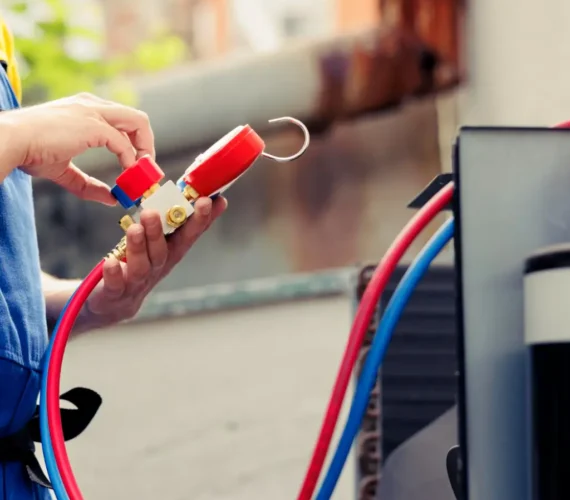
Air conditioning gas filling refers to the process of replenishing the refrigerant gas in your AC system. This gas plays a vital role in cooling by absorbing heat from the indoor air and releasing it outdoors. Without adequate refrigerant levels, the cooling efficiency of your air conditioner will be compromised.
Why is Air Conditioning Gas Important?
The refrigerant gas is the lifeblood of your AC unit. It cycles through the system, enabling heat exchange and ensuring consistent cooling. Here are the primary reasons why maintaining adequate gas levels is crucial:
- Efficient Cooling Performance: Proper gas levels ensure your AC cools the room effectively.
- Energy Efficiency: Low refrigerant levels force the compressor to work harder, increasing energy consumption.
- Prolonged Lifespan: Adequate refrigerant minimizes wear and tear on the compressor, extending the life of your AC unit.
- Prevention of System Damage: Operating an AC with insufficient gas can damage critical components, leading to expensive repairs.
Signs Your Air Conditioner Needs Gas Refilling
Recognizing the signs of low refrigerant levels is vital to address the issue promptly. Here are the most common indicators:
1. Reduced Cooling Efficiency
If your air conditioner is blowing warm or insufficiently cool air, it’s a sign of low refrigerant levels.
2. Hissing or Bubbling Noises
Unusual noises from your AC system could indicate a refrigerant leak. This requires immediate attention.
3. Increased Electricity Bills
A sudden spike in energy bills may result from an overworked compressor due to low gas levels.
4. Ice Formation on the AC Unit
Ice buildup on the evaporator coil or refrigerant lines signifies that the refrigerant is insufficient to absorb heat effectively.
5. Longer Cooling Cycles
If your AC takes longer than usual to cool the room, it might be due to inadequate refrigerant.
Types of Refrigerant Gases Used in Air Conditioners
The choice of refrigerant gas depends on the type and model of the air conditioner. Here are the most commonly used refrigerants:
R-22 (Chlorodifluoromethane)
- Widely used in older air conditioners.
- Being phased out due to environmental concerns.
R-410A (Puron)
- A popular alternative to R-22.
- More energy-efficient and eco-friendly.
R-32
- Known for its low global warming potential (GWP).
- Increasingly used in modern air conditioning systems.
R-134a
- Commonly used in automotive air conditioners.
Hydrocarbons (R-290 and R-600A)
- Highly energy-efficient and environmentally friendly.
- Used in specific AC systems.
Step-by-Step Guide to Air Conditioning Gas Filling
Gas filling is a technical process that requires specialized equipment and expertise. Here is a detailed overview of how professionals handle it:
Step 1: Inspect the AC Unit
The technician checks the AC system for visible signs of damage or refrigerant leaks.
Step 2: Check Refrigerant Levels
Using a pressure gauge, the technician measures the current refrigerant level in the system.
Step 3: Locate and Repair Leaks
If a leak is detected, it is repaired before refilling the gas. Common methods include brazing or using a sealant.
Step 4: Vacuum the System
A vacuum pump is used to remove air and moisture from the system, preparing it for gas refilling.
Step 5: Refill Refrigerant Gas
The technician carefully refills the refrigerator to the manufacturer-recommended levels, ensuring no overcharging or undercharging.
Step 6: Test the System
After refilling, the AC is tested to ensure optimal performance and cooling efficiency.
How Often Should You Refill AC Gas?
There is no fixed interval for gas refilling, as it depends on factors like usage and the presence of leaks. Typically, an AC system does not lose refrigerant unless there is a leak. Regular maintenance can help identify and address potential issues early.
Tips to Prevent Refrigerator Loss
Preventing refrigerant leaks not only saves costs but also ensures your AC operates efficiently. Here are some tips:
- Regular Maintenance: Schedule annual AC servicing to check for leaks and other issues.
- Proper Installation: Ensure the AC is installed correctly by a qualified professional.
- Avoid Overloading the System: Use the AC within recommended settings to prevent strain on components.
- Address minor issues promptly: Small problems, if ignored, can lead to significant refrigerant loss.
Cost of Air Conditioning Gas Filling
The cost of refilling refrigerant varies depending on factors such as:
- Type of Refrigerant: Some gases, like R-410A, are more expensive than others.
- AC Size: Larger units require more refrigerant, increasing the cost.
- Labor Charges: Charges differ based on location and service provider.
Environmental Impact of Refrigerants
Certain refrigerants, such as R-22, contribute to ozone layer depletion and global warming. Opting for eco-friendly alternatives like R-410A and R-32 is an environmentally responsible choice. Governments worldwide are enforcing regulations to phase out harmful refrigerators.
Conclusion
Air conditioning gas filling is a critical maintenance task that ensures the longevity and efficiency of your AC system. By understanding the signs of low refrigerant levels, choosing the right type of gas, and relying on professional services, you can enjoy uninterrupted cooling and energy efficiency. Regular maintenance and timely gas refilling not only enhance comfort but also protect the environment by minimizing harmful emissions.
